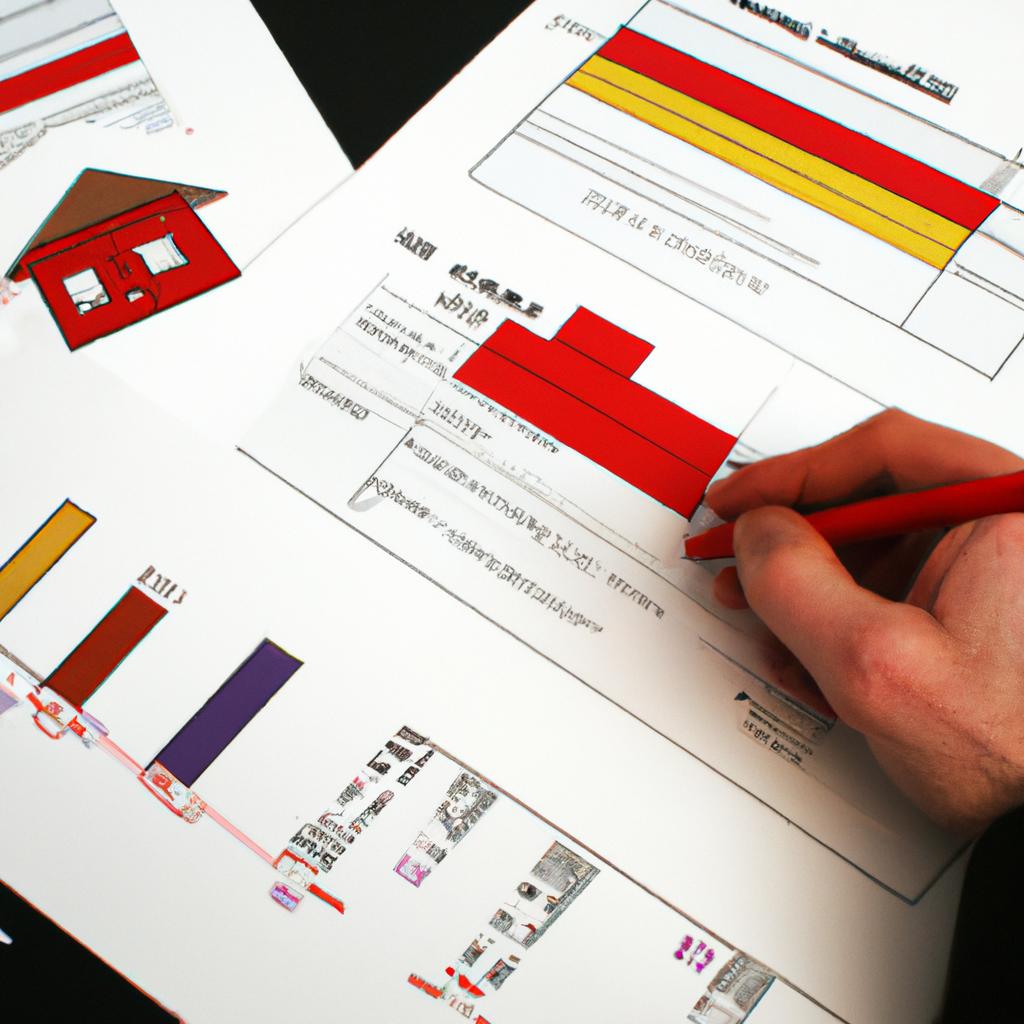In the dynamic and ever-evolving real estate industry, accurate demand forecasting plays a vital role in strategic decision-making for businesses. By analyzing market trends and predicting future demand patterns, real estate companies can optimize their operations, minimize risks, and capitalize on emerging opportunities. This article aims to provide an insightful analysis of demand forecasting from a market perspective, shedding light on its significance and exploring various approaches employed by professionals in the field.
Consider the case of ABC Developers, a renowned real estate company operating in a metropolitan city. Facing challenges with accurately estimating housing demands for their upcoming residential project, they turned to demand forecasting as a solution. Through meticulous data analysis and comprehensive market research, ABC Developers successfully predicted an increasing trend in urban migration coupled with rising middle-class aspirations for luxurious living spaces. Armed with this knowledge, they were able to strategically plan their construction timeline and allocate resources efficiently to meet anticipated demands while staying ahead of competitors.
This article will delve into the intricacies of demand forecasting within the real estate business domain through an extensive market analysis lens. It will address key concepts such as identifying factors influencing demand fluctuations, examining different techniques used for forecasting purposes, and evaluating the benefits and limitations associated with each approach. Furthermore, it will explore how accurate demand forecasts empower businesses to make informed investment decisions, optimize marketing and sales strategies, and effectively manage their inventory.
Accurate demand forecasts empower real estate businesses to make informed investment decisions by providing them with a clear understanding of future market conditions. By predicting housing demands, developers can identify lucrative opportunities for new construction projects or renovations that align with the expected needs of potential buyers or tenants. This allows them to allocate resources strategically, minimizing the risk of investing in properties that may not be in high demand.
Moreover, accurate demand forecasting enables businesses to optimize their marketing and sales strategies. By anticipating the preferences and requirements of prospective buyers or tenants, companies can tailor their promotional efforts to target specific customer segments more effectively. This includes identifying the most suitable channels for advertising and determining appropriate pricing strategies based on projected demand levels. As a result, businesses can maximize their conversion rates and generate higher revenues.
Furthermore, accurate demand forecasts help real estate companies effectively manage their inventory. By understanding future demand patterns, businesses can avoid overstocking or understocking properties, ensuring a proper balance between supply and demand. This not only minimizes holding costs but also reduces the risk of having unsold or vacant units that could lead to financial losses. Additionally, accurate forecasting allows companies to plan construction timelines more efficiently, avoiding delays or shortages in meeting market demands.
However, it is important to acknowledge the limitations associated with demand forecasting in the real estate industry. Market conditions are influenced by various unpredictable factors such as economic fluctuations, government policies, and social trends. These external factors can significantly impact housing demands and render forecasts less reliable. Therefore, it is crucial for businesses to continuously monitor market dynamics and update their forecasting models accordingly.
In conclusion, accurate demand forecasting is essential for strategic decision-making in the real estate industry. It enables businesses to make informed investment decisions, optimize marketing and sales strategies, and effectively manage their inventory. While it comes with its limitations due to external influences on market conditions, a comprehensive analysis of trends and data can provide valuable insights to guide businesses towards success in a dynamic and competitive market.
Understanding Demand Forecasting
In the dynamic and ever-changing real estate market, accurate demand forecasting plays a crucial role in making informed business decisions. By predicting future demand for properties, real estate developers can optimize their resources, minimize risks, and maximize profitability. This section aims to provide an overview of demand forecasting in the real estate industry from a market analysis perspective.
To illustrate the significance of demand forecasting, consider the following hypothetical scenario: A real estate developer plans to construct a residential complex consisting of apartments targeting young professionals in a rapidly growing city. Through careful analysis of market trends, including population growth rates, employment opportunities, and lifestyle preferences of the target demographic, demand forecasters can estimate the level of interest and potential buyers for such units. This information enables developers to determine the optimal number of units to build, amenities to offer, and pricing strategies to adopt.
Demand forecasting incorporates various quantitative and qualitative techniques that analyze historical data, market indicators, economic factors, and consumer behavior patterns. Market research surveys play a pivotal role by gathering insights directly from potential homebuyers or tenants. These surveys help identify key attributes they prioritize when choosing a property—such as location convenience, affordability, safety measures—and enable forecasters to align supply with expected demand.
To evoke an emotional response among readers regarding the importance of demand forecasting in real estate business decision-making processes:
- Ensures resource optimization
- Minimizes financial risks
- Increases return on investment
- Enhances customer satisfaction through tailored offerings
Furthermore, analyzing past sales records combined with macroeconomic factors like GDP growth rate or interest rates helps create statistical models that aid in estimating future demand levels accurately. Integrating these diverse data sources into comprehensive forecasts enhances decision-makers’ ability to adapt quickly to changing market dynamics.
Table 1 below provides an example illustrative summary comparing two scenarios—a well-informed development strategy based on sound demand forecasting versus one without proper estimation:
| Scenario | Well-Informed Development Strategy | No Demand Forecasting |
|---|---|---|
| Construction | Adequate units built | Excess or inadequate |
| Pricing | Optimal pricing strategies | Potential loss |
| Amenities | Tailored to target demographic | Mismatched |
| Profitability | Maximized potential return on investment | Uncertain |
In summary, demand forecasting is a critical tool that real estate developers utilize to make informed decisions in an uncertain market. By analyzing market trends, consumer behavior patterns, and economic indicators, accurate predictions can be made regarding future demand levels. In the subsequent section, we will delve into key factors influencing demand forecasting in the real estate industry and explore their impact on decision-making processes.
Next section: Key Factors Influencing Demand Forecasting
Key Factors Influencing Demand Forecasting
Understanding Demand Forecasting is crucial for businesses operating in the real estate industry. By accurately predicting future demand, companies can make informed decisions regarding pricing, marketing strategies, and resource allocation. In this section, we will delve deeper into the key factors that influence demand forecasting in the real estate business.
One important factor to consider when forecasting demand is the state of the local economy. Economic indicators such as GDP growth rate, employment levels, and inflation rates can significantly impact the demand for real estate. For example, during a period of economic downturn, prospective buyers may delay purchasing properties due to financial uncertainty. Conversely, during an economic boom, increased job opportunities and rising income levels may lead to higher demand for housing.
Another influential factor is demographic trends. Understanding the demographics of potential buyers or renters can help forecast demand more accurately. Factors such as age distribution, household size, migration patterns, and cultural preferences play a significant role in determining housing needs. For instance, an aging population might create a surge in demand for retirement communities or senior living facilities.
Market conditions also affect demand forecasting in real estate business. Factors like interest rates on mortgages and availability of credit impact affordability and thus influence buyer behavior. Additionally, changes in government policies related to taxes or regulations can have direct implications on property investments. For example, tax incentives provided by governments often stimulate home purchases.
To illustrate these factors further:
-
Economic Indicators:
- GDP growth rate
- Employment levels
- Inflation rates
-
Demographic Trends:
- Age distribution
- Household size
- Migration patterns
-
Market Conditions:
- Interest rates on mortgages
- Availability of credit
- Government policies
These elements collectively shape the dynamics of supply and demand within the real estate market.
In summary, understanding the intricate relationship between various factors influencing demand forecasting is essential for success in the real estate business. By considering economic indicators, demographic trends, and market conditions, businesses can develop more accurate forecasts.
Data Collection for Demand Forecasting
Having discussed the key factors influencing demand forecasting, it is essential to explore the process of data collection for accurate and reliable predictions. In this section, we will delve into various methods used to gather pertinent information that aids in determining market demand within the real estate industry.
Data Collection Methods:
- Surveys: Conducting surveys among potential buyers and sellers can provide valuable insights into their preferences, needs, and economic conditions. By collecting responses from a representative sample of the target market, one can derive meaningful conclusions about current demand patterns. For instance, let us consider a hypothetical case study where a real estate developer plans to construct residential apartments targeting young professionals. Through surveys distributed among this demographic group, they can gauge the desired features (e.g., proximity to transportation hubs or recreational facilities), price expectations, preferred locations, and other relevant aspects.
- Understanding customers’ preferences ensures tailored offerings.
- Accurate pricing leads to increased customer satisfaction.
- Timely delivery enhances reputation and attracts more investors.
- Adapting marketing strategies based on survey results optimizes sales efforts.
-
Interviews: Conducting structured interviews with experts such as real estate agents, property managers, economists, or local authorities provides firsthand knowledge of the market dynamics. These conversations help identify emerging trends, regulatory changes affecting demand-supply equilibrium, and external factors impacting buying decisions. Through an example scenario involving interviewing experienced real estate agents operating in a specific locality experiencing rapid urbanization, one can gain insights into upcoming infrastructure developments or government initiatives aimed at enhancing livability—an aspect that significantly influences housing demand.
-
Secondary Research: Utilizing existing sources like databases maintained by government agencies or private research firms allows for the collection of historical market data, demographic trends, economic indicators, and other relevant statistics. By analyzing this information, one can identify patterns and correlations that aid in predicting future demand accurately. For instance, a real estate company could analyze historical sales data from similar projects to estimate the absorption rate and predict demand for an upcoming housing development.
| Advantages | Challenges | Recommendations |
|---|---|---|
| Provides insights into customer needs | Sample bias may affect survey accuracy | Ensure representative sample selection |
| Expert opinions add credibility | Interviewee biases might influence data | Employ standardized interview protocols |
| Access to vast amounts of existing data | Data reliability varies across sources | Verify data quality before analysis |
| Cost-effective compared to primary research | Information overload requires careful analysis | Utilize appropriate tools for data analysis |
In conclusion, effective demand forecasting in real estate necessitates meticulous data collection methods such as surveys, interviews with experts, and secondary research. These approaches provide valuable information about customers’ preferences, prevailing market conditions, emerging trends, and regulatory factors influencing demand dynamics. Armed with this knowledge, businesses operating within the industry can make more informed decisions regarding pricing strategies, marketing efforts, location selection, and product design.
With a solid understanding of data collection techniques established, we can now explore various techniques used for demand forecasting in the field of real estate.
Techniques for Demand Forecasting in Real Estate
Having discussed the crucial process of data collection for demand forecasting in real estate, we now turn our attention to the various techniques used for this purpose. By employing these methodologies, businesses can gain valuable insights into market trends and make informed decisions to maximize their profitability.
Techniques for Demand Forecasting in Real Estate:
To illustrate one such technique, let us consider a hypothetical case study involving a real estate developer planning to construct an apartment complex in a metropolitan area. They aim to forecast the demand for residential properties over the next five years. The developer collects relevant historical sales data, market surveys, and economic indicators before applying statistical models and machine learning algorithms to predict future housing demands accurately.
When it comes to forecasting demand in the highly dynamic real estate industry, several methods have proven effective. These include:
-
Time Series Analysis: This method involves analyzing past demand patterns by examining factors such as seasonality, cyclical fluctuations, and long-term trends. It helps identify regularities that can be used to understand and project future demand.
-
Regression Analysis: By establishing relationships between dependent variables (such as home prices) and independent variables (e.g., income levels or interest rates), regression analysis provides quantitative forecasts based on historical data.
-
Artificial Intelligence (AI) Models: AI-powered technologies leverage sophisticated algorithms capable of processing vast amounts of data quickly. These models extract meaningful patterns from diverse sources like social media sentiment analysis or online search behavior to anticipate shifts in consumer preferences.
-
Market Surveys and Expert Opinions: While relying heavily on data-driven approaches is essential, incorporating qualitative inputs from potential buyers or industry experts through surveys or interviews adds another dimension to understanding market dynamics.
Table 1: Advantages of Different Demand Forecasting Techniques
| Technique | Advantages |
|---|---|
| Time Series Analysis | – Helps identify trends and patterns in demand over time.- Provides a historical context for forecasts. |
| Regression Analysis | – Allows for quantification of relationships between variables.- Supports data-driven decision-making. |
| AI Models | – Rapidly processes large volumes of diverse data sources.- Identifies emerging consumer preferences. |
| Market Surveys | – Offers qualitative insights from potential buyers or industry experts.- Complements quantitative methods. |
Forecasting demand accurately presents numerous benefits to real estate businesses, such as optimizing pricing strategies, streamlining inventory management, and identifying new market opportunities. By employing appropriate techniques like time series analysis, regression analysis, AI models, and market surveys, companies can better anticipate shifts in demand dynamics and stay ahead of their competitors.
While understanding various forecasting techniques is crucial for effective demand prediction, it is equally important to acknowledge the challenges that arise during this process. These obstacles require careful consideration to ensure accurate results and will be discussed in detail in the following section.
Challenges in Demand Forecasting
Having discussed various techniques for demand forecasting in the real estate sector, it is crucial to understand the challenges associated with this process. By addressing these obstacles, market players can enhance their decision-making capabilities and mitigate potential risks.
To illustrate the complexities involved in demand forecasting, let us consider a hypothetical case study of a real estate developer planning to construct a residential project in an urban area. This example will shed light on some common challenges faced by industry professionals:
-
Market Uncertainty: The real estate market is inherently unpredictable due to numerous external factors such as economic conditions, government policies, and changing consumer preferences. These uncertainties make accurate demand forecasting a daunting task.
-
Data Limitations: Reliable data plays a pivotal role in forecast accuracy; however, obtaining comprehensive data sets can be challenging. Real estate projects often involve large investments and extended timeframes, resulting in limited historical data availability or outdated information that may not accurately reflect current market trends.
-
Seasonal Variations: Certain property types experience seasonal fluctuations in demand. For instance, vacation homes might see increased interest during summer months but decreased activity during colder seasons. Incorporating such variations into forecasts requires careful analysis and consideration.
-
External Influences: Factors beyond direct control, including environmental concerns or geopolitical events, can significantly impact real estate markets. Political instability, natural disasters, or changes in infrastructure development plans are examples of external influences that complicate demand forecasting efforts.
| Challenges | Impact | Possible Mitigation Strategies |
|---|---|---|
| Market uncertainty | Difficulty making informed decisions | Conduct thorough market research |
| Data limitations | Inaccurate forecasts | Enhance data collection methods |
| Seasonal variations | Discrepancies between projected and actuals | Analyze past patterns and incorporate seasonality |
| External influences | Unforeseen shifts in market dynamics | Stay updated with relevant news and anticipate disruptions |
Addressing these challenges requires industry professionals to adopt a comprehensive approach that combines both quantitative analysis and qualitative insights. By doing so, stakeholders can better navigate uncertainties and improve the accuracy of their demand forecasts.
By understanding the challenges involved in demand forecasting, real estate businesses can now explore the benefits of accurate predictions. This will shed light on why investing time and resources into refining this process is essential for long-term success.
Benefits of Accurate Demand Forecasting
Section: Factors Affecting Demand Forecasting Accuracy
Demand forecasting in the real estate business is a crucial aspect that requires careful analysis and consideration. Accurate demand forecasting helps businesses make informed decisions regarding their investments, pricing strategies, and overall market positioning. However, there are several factors that can impact the accuracy of these forecasts.
One example illustrating the challenges faced in demand forecasting relates to changes in economic conditions. For instance, during times of economic downturn, potential buyers may delay their purchasing decisions due to financial uncertainties or limited access to credit. On the other hand, during periods of economic growth, increased consumer confidence and disposable income often lead to higher demand for properties. Thus, accurately predicting these fluctuations becomes essential for real estate developers and investors.
Several key factors affect the accuracy of demand forecasting in the real estate industry:
- Demographic Changes: Shifts in population demographics play a significant role in determining housing demands. Factors such as age distribution, migration patterns, household size, and income levels all influence the types and quantity of properties needed within a specific region or market segment.
- Market Trends: Keeping abreast of market trends is crucial for accurate demand forecasting. This includes analyzing current property prices, rental rates, vacancy rates, supply-demand dynamics, and government policies related to the real estate sector.
- Technological Advancements: Technological advancements have revolutionized various aspects of the real estate industry over recent years. Assessing how emerging technologies like virtual reality tours or online property portals impact buyer behavior is vital for reliable demand forecasting.
- Environmental Considerations: Increasing awareness about sustainability and environmental impacts has led to growing interest in eco-friendly buildings among consumers. As a result, understanding changing preferences towards energy-efficient structures can significantly impact demand forecasts.
To better understand these influencing factors on demand forecasting accuracy within the real estate industry context , consider Table 1 below:
| Factor | Impact on Demand Forecasting |
|---|---|
| Demographic Changes | High |
| Market Trends | Moderate |
| Technological Advancements | Moderate |
| Environmental Considerations | Low |
Table 1: Factors Impacting Demand Forecasting Accuracy
Considering the intricate relationship between these factors, real estate businesses must conduct thorough market analyses to ensure their demand forecasts are as accurate as possible. By leveraging data-driven insights and incorporating the aforementioned factors into their forecasting models, companies can make informed decisions that align with market demands.
Overall, accurately predicting demand in the real estate industry is vital for strategic decision-making. Understanding the challenges faced and acknowledging the influencing factors discussed above allows businesses to fine-tune their analysis and improve overall forecasting accuracy. By doing so, they increase their chances of success in a competitive market environment while minimizing potential risks associated with inaccurate estimations.




